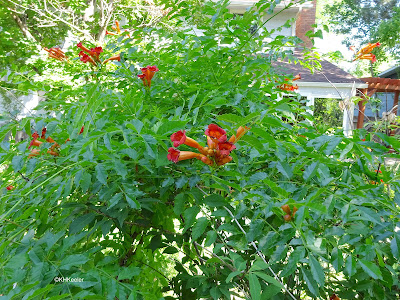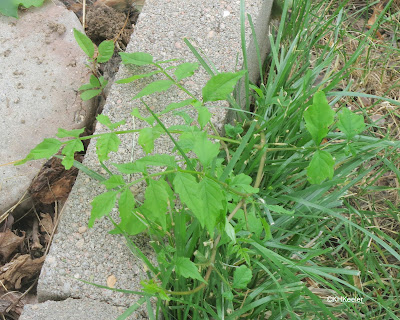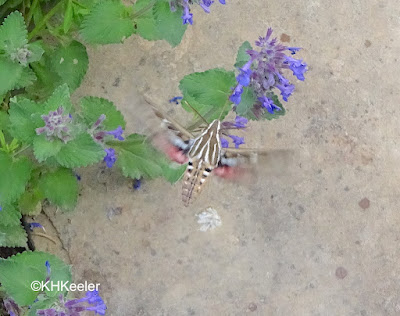Trumpet creeper, also called trumpet vine, Campsis radicans (catalpa family, Bignoniaceae) has for years been one of my favorite plants. The flowers are spectacularl: large red tubes, classical hummingbird-pollinated shape. The tropics has many plants like this, but in New York and Ohio, trumpet vine stood out. In those areas, it was easy to recognize. Add to the red flowers, long leaves with five or more paired leaflets and one more leaflet at the tip and a woody base, and you see how I knew it when I saw it. And it had an easy common name, trumpet creeper, obvious and descriptive.

This big plant is native to the southeastern United States where it is a magnet for ruby-throated hummingbirds, but also for long-tongued native bees and moths. It attracts other flower visitors, like smaller bees, and perhaps they sometimes pollinate. For bees getting nectar is a project since they have to climb into each flower, not just hover in front of it like a hummingbird. The nectar is so good that both the Northern Oriole and Orchard Oriole feed from the flowers.
Being very attractive to people, trumpet creeper has been planted all over the U.S. and has naturalized so that you can find it growing wild well outside its native range, into Upper Midwest and in California, for example. Horticulturalists have produced flowers that are redder, more orangy, and almost yellow.
Trumpet creeper has the habits of a warm climate plant: it leafs out in very late spring and drops its leaves with the first frosts. But the big roots and the woody stem protect it; mine has survived in northern Colorado for easily 20 years.
 |
Campsis radicans, trumpet creeper
|
Campsis is from the Greek kampe, curved or bent, referring to the stamens. The species epithet radicans means rooting, alluding to the plant's tendency to sucker. Less common common names include hellvine, cowvine, devil's shoestring, and cow-itch vine. Spell check corrects the scientific name to campus radicals.
In 1972 I noticed extrafloral nectaries (
link, nectaries produce sugar-water, extrafloral nectaries do it outside the flower) for the first time, on an Organization for Tropical Studies ecology course in Costa Rica. All excited, I came back, researched the subject, and got a grant to study them for my Ph.D. During the writing of my thesis, I encountered Tom Elias, then at the New York Botanic Garden, who studied the extrafloral nectaries of trumpet creeper. He found nectaries at the base of the leaves (petioles), base of the flower (calyx), on the outside of the petals (corolla), and on the outside of the developing fruit (seed pod), as well as floral nectaries in the flower to reward pollinators. And he and Hellen Gelband showed that ants attracted to all those extrafloral nectaries provide defense for the plant, driving off insects that would eat it. In the 1970s extrafloral nectaries had not been studied since 1932, so the Elias and Gelband papers were among the first of the new era, demonstrating plant defense by extrafloral nectary visitors to modern science. How could I not like the plant even more when it had so many extrafloral nectaries, my study subject for more than a decade?
The house I bought in retirement had a big established trumpet creeper climbing the arbor in the middle of the back yard. How very cool!
Ten years on, I'm less fond of the trumpet creeper. It suckers! It sends shoots out of the ground. Around the base of the plant, sure. But 25 feet away?!
Others have remarked on how aggressive it can be. In its native range, it forms virtually impenetrable thickets. Southern Living actually recommended growing a
Campsis species from Asia rather than our native
Campsis radicans, it is that invasive. (
link)
 |
sucker from trumpet creeper
|
It reaches out and would climb the neighboring shrubs if I let it. The branches are heavy; in a wind storm they can bring down large tree branches the trumpet vine is climbing over.
The fruit are bean-like pods, 3-5" long. They contain winged seeds that float on the wind. I don't get much pollination and so rarely see the pods.
 |
| pod, Campsis radicans, trumpet creeper |
But it is a North American native vine and the host to at least seven species of butterflies and moths. One of those is the white-lined sphinx moth,
Hyles lineata, a favorite of mine. So, on second thought, I will likely keep the trumpet creeper because I love seeing sphinx moths. Colorado is outside the natural range of trumpet creeper, but the white-lined sphinx moth is native here; while white-lined sphinx moths feed on trumpet creepers in the Southeast where both are native, in Colorado this is probably an example of opportunistic pairing of a native insect with a nonnative it can feed on, an uncommon but positive interaction. In the southeast, the native range of trumpet creeper, it hosts another sphinx moth as well, the trumpet vine sphinx moth,
Paratraea plebeja. The trumpet vine mo
th, Clydonopteron sacculana, a snout moth found from Washington DC. west to Missouri and Texas and south into Central and South America, lays eggs in the seeds of trumpet creeper. And there are more.
 |
| white-lined sphinx moth, Hyles lineata on my catmint (Nepeta) |
Vertebrates find the leaves slightly toxic, so trumpet creepers are little bothered by deer or rabbits. In fact, the compounds in the leaves irriate the skin of some people. I have never noticed that myself...but I tend to wear gloves when I garden, so as not to have perpetually dirty nails.
Trumpet creeper is a beautiful, aggressive native vine that attracts a lot of native wildlife. Grow it with care or enjoy it on someone else's fence.
Comments and corrections welcome.
References
Bender, S. No date given. Just say no to trumpet vine. Southern Living link Accessed 3/31/22.
Candeias, M. 2018. The Trumpet Creeper. Indefenseofplants blog. link Accessed 3/31/22.
Elias, T.S. and H. Gelband. 1975. Nectar: Its Production and Functions in Trumpet Creeper. Science 189: 289-291. link
Elias, T. S. and H. Gelband. 1976. Morphology and anatomy of floral and extrafloral nectaries in Campsis (Bignoniaceae). American Journal of Botany. 63: 1349-1353. link
Hilty. J. Illinois Wildflowers. Trumpet Creeper, Campsis radicans https://www.illinoiswildflowers.info/trees/plants/trumpet_creeper.htm Accessed 3/31/22.
Missouri Botanical Gardens. Campsis radicans. Missouri Plant Finder link Accessed 3/31/22.
Wolf River Conservancy. 2020. Natural Highlights: Trumpet Vine. link Accessed 3/31/22.








I absolutely love reading about the trumpet creeper! The trumpet vine's ability to attract various pollinators, from hummingbirds to native bees, is truly remarkable. It’s fascinating how it has adapted to different climates and environments. If you're interested in learning more about how to propagate trumpet vine, I highly recommend checking out this helpful guide: How to Propagate Trumpet Vine. It offers great tips on successfully growing and maintaining this beautiful plant. The detailed history and unique features of trumpet creeper make it a must-have for any garden enthusiast!
ReplyDeleteWoody
ReplyDelete